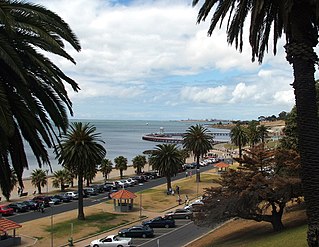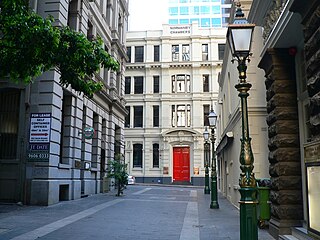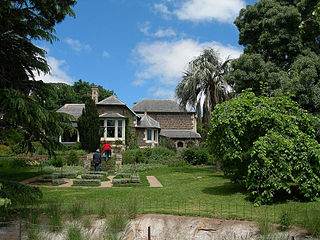
Geelong is a port city in Victoria, Australia, located at the eastern end of Corio Bay and the left bank of Barwon River, about 75 km (47 mi) southwest of Melbourne. With an estimated population of 282,809 in 2023, Geelong is the second largest city in the state of Victoria. It is the administrative centre for the City of Greater Geelong municipality, which is Port Phillip's only regional metropolitan area, and covers all the urban, rural and coastal reserves around the city including the entire Bellarine Peninsula and running from the plains of Lara in the north to the rolling hills of Waurn Ponds to the south, with Corio Bay to the east and the Barrabool Hills to the west.

Queen Victoria Village, generally known as QV Melbourne or just QV, is a precinct in the Melbourne central business district, Victoria, Australia. Covering the city block bounded by Lonsdale, Little Lonsdale, Swanston, and Russell Streets, and located directly opposite the State Library of Victoria and Melbourne Central, QV comprises a large shopping centre, a central plaza, an underground food court, Melbourne central city's first full-size supermarket and apartment buildings.

Parliament House is the meeting place of the Parliament of Victoria, one of the eight parliaments of the Australian states and territories.

Norlane is a northern suburb of Geelong, in Victoria, Australia. Norlane is bordered in the south by Cowies Creek, in the north by Cox Road, in the west by Thompson Road and in the east by Station Street. It is about 7 km from the Geelong central business district and approximately 70 km from the state capital, Melbourne. It is about one kilometre from the shore of Corio Bay. At the 2016 census, Norlane had a population of 8,306.
Newtown is an inner western suburb of Geelong, Victoria, Australia. At the 2021 census, Newtown had a population of 10,445. It is a primarily residential area occupying one of the highest points of urban Geelong. It has always been a desirable place of residence and is the location of many of Geelong's oldest and most valuable properties.
East Geelong is a residential suburb of Geelong, Victoria, Australia. At the 2016 census, East Geelong had a population of 3,862.

Flagstaff Gardens is the oldest park in Melbourne, Victoria, Australia, first established in 1862. Today it is one of the most visited and widely used parks in the city by residents, nearby office workers and tourists. The gardens are notable for their archaeological, horticultural, historical and social significance to the history of Melbourne.

Eastern Beach is a popular swimming and recreation area in Geelong, Victoria on the shores of Corio Bay. Built during the 1930s in the Art Deco style, a shark proof sea bath is provided, as well as a children's swimming pool, kiosk, and dressing room pavilion. A number of Art Deco buildings in the area are listed on the Victorian Heritage Register.

Government House is the official residence of the Governor of Victoria, currently Margaret Gardner. It is located in Kings Domain, Melbourne, next to the Royal Botanic Gardens.

The Adelaide Botanic Garden is a 51-hectare (130-acre) public garden at the north-east corner of the Adelaide city centre, in the Adelaide Park Lands. It encompasses a fenced garden on North Terrace and behind it the Botanic Park. Work was begun on the site in 1855, with its official opening to the public on 4 October 1857.

John James Clark was an Australian architect, who began his career at the age of 14 in the office of the Colonial Architect's Office in Melbourne, immediately after his family migrated from Liverpool in 1852. Clark's 30 years in public service, followed by 33 in private practice, produced some of Australia's most notable public buildings, and at least one in New Zealand. He is most famous as the designer of Melbourne's Old Treasury Building aged only 19.

Bank Place is a street in the Melbourne central business district, Australia. It is a laneway running roughly north-south between Collins Street and Little Collins Street.

The Christ Church is an Anglican church located in Geelong, Victoria, Australia. Designed by Edmund Blacket, the church is the oldest Anglican church in Victoria, in continuous use on its original site.

Moorabool is a closed railway station on the Geelong–Ballarat railway line, in the locality of Moorabool, Victoria, Australia. Until 1864 it was called Steiglitz Road. The station building was constructed for the Victorian Railways in 1861, by a private contractor, and comprises a single-storey, gable-roofed, bluestone station building, with an attached two-storey residence.

The Shamrock Hotel, currently trading as Hotel Shamrock, is a grand 19th-century hotel in Bendigo, Victoria, Australia, situated on Pall Mall, the city's main street.

Heronswood is a heritage-listed house located in Dromana, on the Mornington Peninsula in Victoria, Australia. Classified by the National Trust of Australia and open to the public, the house, completed in the Gothic Revival style, is listed on the Australian Heritage Places Register, and the Victorian Heritage Register.

The architecture of Melbourne, Victoria, and Australia is characterised by a wide variety of styles. The city is particularly noted for its mix of Victorian architecture and contemporary buildings, with 74 skyscrapers in the city centre, the most of any city in the Southern Hemisphere.
Shannon Bennett is an Australian chef and author. He is best known as the head chef of restaurant Vue de Monde at Melbourne's Rialto Tower. Bennett currently serves as the creative director at the restaurant and its parent company Vue Groups, having previously been the executive chef. He has made many appearances as a guest judge on the popular cooking show MasterChef Australia.
Bellarine is a rural locality in the City of Greater Geelong, Victoria, Australia. In the 2011 census, the population of Bellarine was too low to separately report; however in June 2014 the Victorian Electoral Commission recorded 134 enrolled voters in Bellarine, living in 81 properties.

Cairo Flats, also colloquially known as Cairo Bachelor Flats or Cairo, is a heritage-listed apartment building in the Melbourne inner city suburb of Fitzroy. Cairo Flats is situated opposite the Royal Exhibition Building in the Carlton Gardens, a UNESCO World Heritage Site. As a result, Cairo also sits within the World Heritage Environs Area (WHEA) overlay that surrounds this precinct.
















